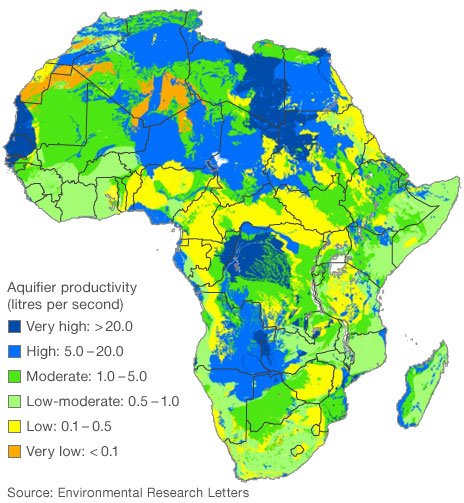– ‘Huge’ water resource exists under Africa (BBC News, April 20, 2012):
Scientists say the notoriously dry continent of Africa is sitting on a vast reservoir of groundwater.
They argue that the total volume of water in aquifers underground is 100 times the amount found on the surface.
The team have produced the most detailed map yet of the scale and potential of this hidden resource.
Writing in the journal Environmental Research Letters, they stress that large scale drilling might not be the best way of increasing water supplies.
Across Africa more than 300 million people are said not to have access to safe drinking water.
Demand for water is set to grow markedly in coming decades due to population growth and the need for irrigation to grow crops.
Freshwater rivers and lakes are subject to seasonal floods and droughts that can limit their availability for people and for agriculture. At present only 5% of arable land is irrigated.
Now scientists have for the first time been able to carry out a continent-wide analysis of the water that is hidden under the surface in aquifers. Researchers from the British Geological Survey and University College London (UCL) have mapped in detail the amount and potential yield of this groundwater resource across the continent.
Helen Bonsor from the BGS is one of the authors of the paper. She says that up until now groundwater was out of sight and out of mind. She hopes the new maps will open people’s eyes to the potential.
“Where there’s greatest ground water storage is in northern Africa, in the large sedimentary basins, in Libya, Algeria and Chad,” she said.
“The amount of storage in those basins is equivalent to 75m thickness of water across that area – it’s a huge amount.”
Ancient events
Due to changes in climate that have turned the Sahara into a desert over centuries many of the aquifers underneath were last filled with water over 5,000 years ago.
The scientists collated their information from existing hydro-geological maps from national governments as well as 283 aquifer studies.
The researchers say their new maps indicate that many countries currently designated as “water scarce” have substantial groundwater reserves.
However, the scientists are cautious about the best way of accessing these hidden resources. They suggest that widespread drilling of large boreholes might not work.
Dr Alan MacDonald of the BGS, lead author of the study, told the BBC: “High-yielding boreholes should not be developed without a thorough understanding of the local groundwater conditions.
“Appropriately sited and developed boreholes for low yielding rural water supply and hand pumps are likely to be successful.”
With many aquifers not being filled due to a lack of rain, the scientists are worried that large-scale borehole developments could rapidly deplete the resource.
According to Helen Bonsor, sometimes the slower means of extraction can be more efficient.
“Much lower storage aquifers are present across much of sub-Saharan Africa,” she explained.
“However, our work shows that with careful exploring and construction, there is sufficient groundwater under Africa to support low yielding water supplies for drinking and community irrigation.”
The scientists say that there are sufficient reserves to be able to cope with the vagaries of climate change.
“Even in the lowest storage aquifers in semi arid areas with currently very little rainfall, ground water is indicated to have a residence time in the ground of 20 to 70 years.” Dr Bonsor said.
“So at present extraction rates for drinking and small scale irrigation for agriculture groundwater will provide and will continue to provide a buffer to climate variability.”
The publication of the new map was welcomed by the UK’s secretary of state for international development, Andrew Mitchell.
“This is an important discovery,” he said. “This research, which the British Government has funded, could have a profound effect on some of the world’s poorest people, helping them become less vulnerable to drought and to adapt to the impact of climate change.”
